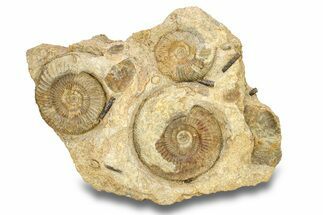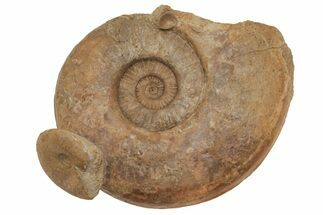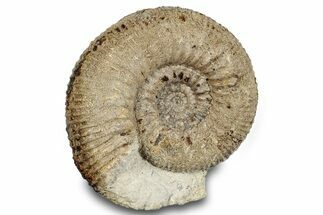This Specimen has been sold.
4.1" Jurassic Sea Urchin (Clypeus) Fossil In Rock - England
This is a very displayable fossil sea urchin (Clypeus plotti) that was collected near Stow-on-the-Wold in Gloucestershire, England. It comes from Middle Jurassic, Bajocian age Clypeus Grit Member of the Inferior Oolite, and is approximately 168 million years old. The sea urchin is partially embedded in the rock it was found in. It comes with an acrylic display stand.
A relatively unknown and interesting little fact about 14th century England is that these fossil sea urchins were so abundant and of such consistent size and mass (one pound exactly) that Oxfordshire milk-maids used them as a counterweight for butter scales up into the 18th century. These fossils, which were inexplicably found in the thousands lying in open fields far from the sea, were known as "Checkbury Buns", "Chedworth Buns" or "Poundstones". They became so popular that they started being used for weights in all other materials such as beads, wool, or flour. But since different numbers of stones were used for different sale items, trade with other countries was very difficult, so a royal statute in 1389 decreed that the official poundstone, or "stone" for short, would be 1 stone for butter, 26 stones for a sack of wool and 5 stones for glass. That is how today's English measurement for people and animals, the stone, got its origins.
While these urchin fossils sparked mild curiosity, it wasn't until scientific discovery progressed that geologists realized these poundstones were not only weights but evidence of ancient oceans that once covered England.
While these urchin fossils sparked mild curiosity, it wasn't until scientific discovery progressed that geologists realized these poundstones were not only weights but evidence of ancient oceans that once covered England.
SPECIES
Clypeus plotti
LOCATION
Stow-on-the-Wold, Gloucestershire, England
FORMATION
Clypeus Grit Member, The Inferior Oolite
SIZE
4.1" wide urchin, rock measures 5.7 x 4.3"
CATEGORY
SUB CATEGORY
ITEM
#177051
We guarantee the authenticity of all of our specimens.
 Reviews
Reviews











